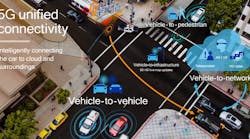Qualcomm Doubles Down on Cellular Chips for Wireless Vehicle Communications
In wagering on sports there are opportunities where you might want to hedge your bet. If you are holding a parlay bet and all but one of your teams have won their contests, you might choose to place a new bet on the team opposing your last selection as a hedge against your parlay. This guarantees you a small profit if the final team loses while still leaving open the possibility for a big win should the parlay come in.
Turns out that vehicle-to-everything (V2X) communications is ripe for such a stratagem, especially if you are Qualcomm Technologies and you’re a player on both sides of an upcoming technology battle.
Perhaps a bit of background is in order here. In December 2016, the National Highway Traffic Safety Administration (NHTSA) proposed to mandate a particular V2V (vehicle-to-vehicle) technology standard—dedicated short-range communications (DSRC)—for all new light vehicles. As a result, the IEEE approved an amendment to the IEEE 802.11 standard (designated 802.11p) to add wireless access in vehicular environments (WAVE), a vehicular communication system. 802.11p defines enhancements to 802.11 (the basis of products marketed as Wi-Fi) required to support Intelligent Transportation System (ITS) applications. This includes data exchange between high-speed vehicles and between the vehicles and the roadside infrastructure (V2X communication) in the licensed ITS band of 5.9 GHz (5.85-5.925 GHz).
For its part, Qualcomm Technologies supports IEEE 802.11p-based products (with its QCA6584, for example, which is commercially available today), and is currently developing a third-generation DSRC/ITS-G5 product. Qualcomm also acquired Atheros in 2011, where DSRC technology development and standardization had been ongoing since 2004.
Ah, but here’s the rub: Since NHTSA recognized the need for DSRC it has become less clear that it is the best technology for the job. A growing subset in the industry believes it will be eclipsed by a competing cellular-based technology called C-V2X.
C-V2X technology encompasses two transmission modes, direct communications, and network-based communications. It promises to be able to connect cars to any objects that either have sensors or cellular compatibility. That potentially can include cameras, traffic signs, stoplights, and smartphones. Suppliers championing C-V2X view it as an essential step toward self-driving cars because it can help these cars detect obstructions not visible to the driver.
Now that you are up to speed on DSRC and C-V2X, it is easier to understand the significance of Qualcomm Technologies’ announcement this morning, in which the company seems to indicate it is willing to place a wager on both competing technologies. Qualcomm’s new 9150 chipset is its first C-V2X commercial solution based on 3rd Generation Partnership Project (3GPP) Release 14 specifications. The 9150 C-V2X chipset is anticipated to be available for commercial sampling in the second half of 2018. It is said by the company to offer the industry enhanced V2X capabilities, including extended communication range, improved reliability and NLOS (non-line-of-sight) performance to expand support for safety and autonomous driving use cases.
Qualcomm also introduced today the new C-V2X Reference Design, which will feature the 9150 C-V2X chipset with integrated GNSS capability, and include an application processor running the Intelligent Transportation Systems (ITS) V2X stack and a Hardware Security Module (HSM).
Qualcomm put its support for C-V2X this way: “C-V2X direct communications is designed to support active safety and helps enhance situational awareness by detecting and exchanging information using low latency transmission in the globally harmonized 5.9 GHz ITS band for Vehicle-to-Vehicle (V2V), Vehicle-to-Infrastructure (V2I) and Vehicle-to-Pedestrian (V2P) scenarios without the need for a Subscriber Identity Module (SIM), cellular subscription or network assistance.”
Complementing direct communication transmissions, the network-based communications is designed to utilize the wireless operator’s 4G and emerging 5G wireless networks for Vehicle-to-Network (V2N) and operates over licensed operator spectrum to support telematics, connected infotainment and a growing variety of advanced informational safety use cases.
Qualcomm already has multiple automotive partners endorsing the new chipset, including Ford, Audi, the PSA Group (Peugeot, Citroen, Opel, Vauxhall), and SAIC of Shanghai.
“Groupe PSA is strongly involved in the 5G standardization and trials and has great expectations on 5G as an enabler for the connected and autonomous vehicles,” said Carla Gohin, senior vice president, head of innovation, Groupe PSA. “C‐V2X and its strong evolution path to 5G will serve as a key enabler for new mobility services. Groupe PSA will evaluate this technology, with Qualcomm Technologies’ support, to adopt for our cars.”

